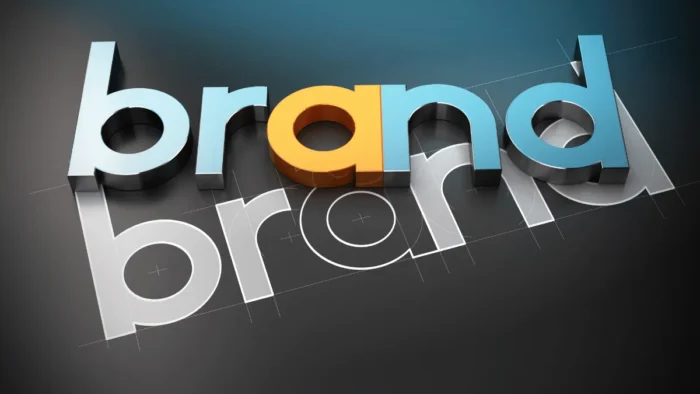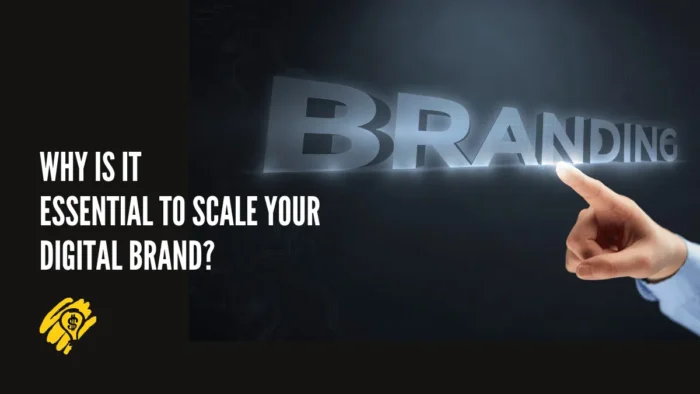Increasing your brand potential has never been more critical. As an entrepreneur or brand manager, understanding and increasing your brand’s potential can be the difference between market insignificance and a leadership position. Exploring actionable strategies to strengthen and expand your brand’s influence is a core element of your growth strategy.
This guide will walk you through the essential steps to improve your brand potential – and keep it thriving.
What is Brand Potential
Before strategizing ways to enhance your brand potential, it is vital to comprehend what it actually is. Brand potential refers to the scope and possibilities for expansion and growth within your target market. It encapsulates the areas where your brand could excel and the untapped reservoirs of positive public perception that it could leverage.
Brand potential can be viewed as the elasticity or growth of your brand. Various components can be measured, including brand loyalty, customer base expansion, market share growth, and brand value enhancement. When properly harnessed, your brand’s potential allows you to seize new opportunities, defend against market threats, and build long-term resilience.
What is a Brand Potential Index (BPI)?
The Brand Potential Index (BPI), also known as the brand relevance index, is a metric that assesses how well a brand is engaging and fulfilling the needs of its customers. It can also be used to forecast future sales and allocate appropriate advertising budgets.
A higher brand potential index indicates a strong, growth-oriented brand.
Calculation of Brand Potential Index (BPI)
The traditional calculation of the Brand Potential Index involves two core metrics: the Brand Development Index (BDI) and the Market Development Index (MDI).
- BDI (Brand Development Index) measures your brand performance, or how well your brand performs within a specific target market compared to its performance in a larger reference market. It is usually calculated by dividing the percentage of your brand’s sales in the market in the specific region by the percentage of the national population in the market.
- MDI (Market Development Index) assesses the potential for development within a market. It can be determined by dividing the market’s brand’s actual number of customers by the potential number of customers. So, this measure will tell you how much future sales you can expect from the specific market or potential future performance by implementing brand improvement strategies.
These metrics provide a view of brand strength regarding current brand performance and the available headroom for growth within specific markets.
The brand potential index will be the ratio between the brand development index and the market development index.
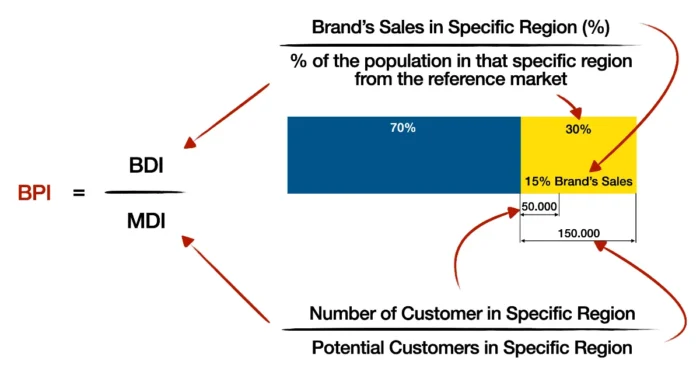
Let’s look at one example. If your brand’s sales to the specific region are 15% and the total population of that region is 30% of the reference market, let’s say the nation’s market. In that case, brand development index would be 0,5:
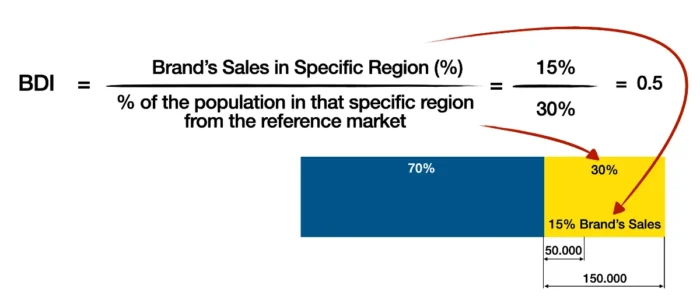
On the other side, when it comes to the market, if the brand’s actual number of customers is 50.000 in a specific market and the potential number of customers is 150.000, then the market development index will be 0,33.
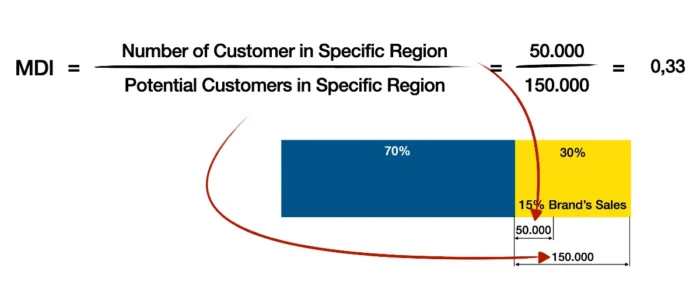
Now, you must calculate the brand potential index as a ratio between the brand development index and the market development index. So, we will divide BDI with MDI: 0,5/0,33 = 1,5.
Meaning of Brand Potential Index
To understand the meaning of your brand potential index, you have calculated using the explained process above. Let’s consider the ideal results and the meaning of such a result.
If your brand’s sales to the specific region are 100% and the total population of that region is 30% of the reference market, let’s say the nation’s market, your brand development index would be 3,33.Conversely, if the brand’s actual number of customers is 150.000 in a specific market and the potential number of customers is 150.000, then the market development index will be 1. When we divide 3,33 by one, the brand potential index will be 3,33.
As you can see, if you want to increase brand strength and have a higher brand potential index, you must increase the BDI and/or decrease the MDI. Increasing BDI means higher sales because of better brand recognition, awareness, equity, engagement, sentiment, and customer loyalty. On the other side, decreasing MDI will mean that you will have a higher market potential, expanding potential customers in the specific market, which means that there will always be more room for higher market penetration.
According to this example, because we can not impact the percent of the population of that specific region as the total nation population and potential customers at a specific region, we can work on improvement of other elements of the formula like:
- improvement of the brand’s sales in the specific region and
- increase the number of potential customers in a specific region.
But it is not so simple. You must take into account the market dynamics. So, let’s see how it will impact your brand potential index.
Related: Key Differences Between a Value Proposition and Positioning Statement
Market Dynamics and the Brand Potential Index
Market dynamics refer to the forces that impact the supply and demand of products and services within a specific market, thus influencing the business environment. Key factors include changes in consumer preferences, economic conditions, and competitor actions. These dynamics can significantly affect both the brand development index and the market development index – and, because of them, the brand potential index (BPI).
- Consumer preferences: Shifts in what consumers want and need will directly impact the appeal of your brand and its products, often seen in fluctuating sales figures (which in turn affect BDI).
- Economic conditions: A strong economy might expand the pool of potential customers, decreasing the MDI and potentially increasing the BPI as a market shows a greater capacity for brand adoption.
- Competitor actions: Competing brands introducing innovative products or aggressive marketing strategies can change your brand’s performance relative to the market average, thus impacting your BDI.
For instance, suppose a competitor launches a product that gains rapid market acceptance. As a result, your brand’s sales might decline, decreasing your BDI. If the overall market size remains constant, your BPI will subsequently fall. However, if your brand can adapt by innovating and better meeting customer needs, you could recapture market share and improve your BDI, potentially boosting your BPI once more.
So, by keeping a finger on the pulse of market dynamics, you can identify brand weaknesses and understand their influence on your BDI and MDI; you can more accurately measure and later strategize to improve your BPI. It is a continuous process of monitoring and adaptation – by strategically responding to market changes, you can maintain and even strengthen your brand’s potential in the face of constant change.
Brand Potential Analysis – How to Calculate Your Brand Potential
To analyze your brand’s potential holistically, consider various dimensions that collectively contribute to your brand’s strength and resilience.
Determining the success of your brand potential strategy is crucial. Which KPIs can you use to measure the effectiveness of your brand management efforts?
Brand Awareness and Recognition
Brand awareness is how familiar your target audience is with your brand or what the knowledge of customers is that your brand exists. Building strong brand awareness is essential in the early stages of your business development and brand’s life cycle, as it creates the foundation for other brand potential factors. A high level of brand awareness will
For brand awareness, look at different metrics such as:
- Brand mentions like total brand mentions through social media, blogs, news, websites, or forums (positive or negative), and share of voice, which is the share of mentions you get compared with your competitors.
- Customer reviews like average positive or negative reviews on review sites, average survey results of brand awareness, and net promoter score (NPS).
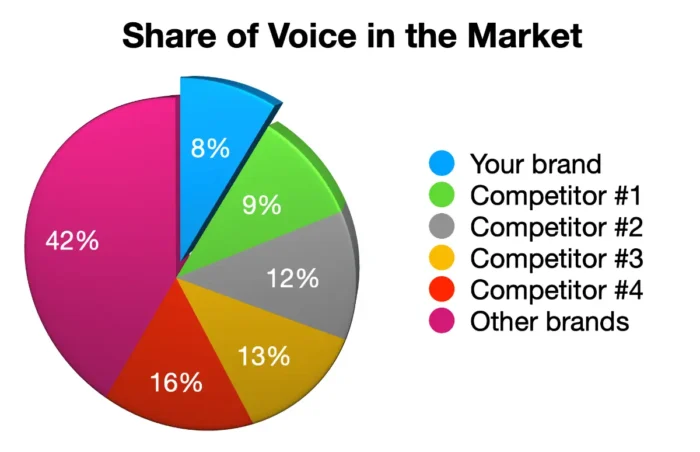
Because brand awareness impacts your brand potential index, you must follow these KPIs and find out where you need to make a further investment in your marketing efforts to improve your brand awareness and recognition.
While often used interchangeably, brand awareness and brand recognition are different concepts within brand management. As I already mentioned, brand awareness refers to the extent to which consumers are familiar with a brand’s presence. In contrast, brand recognition is the ability of consumers to identify your brand under different conditions, as reflected by their ability to recognize your name, logo, jingles, packaging, or other characteristic traits.
Brand Association
Brand association refers to the relations that consumers make between a brand and its specific qualities or characteristics. These associations can be based on direct experiences, beliefs, feelings, perceptions, or shared values. Strong brand associations positively impact brands, as they help differentiate your brand from its competitors, influencing consumer preference and loyalty.
An association’s impact on your brand potential index (BPI) is tangible; positive associations can increase sales and market share, thus improving a brand’s BDI. Conversely, negative associations might harm these metrics.
To monitor this association, use KPIs such as:
- Functional associations: Measure how well consumers recognize brand attributes, like quality level, value of money, eco-friendliness, or innovativeness.
- Emotional associations: Measure emotional associations to emotional feelings customers have toward your brand, such as happiness, anger, nostalgia, luxury, etc.
Brand Loyalty
The degree to which your customers consistently choose your brand over others indicates brand loyalty. This can be evaluated using repeat purchase rate, customer retention rate, and the likelihood of customers recommending your brand, such as net promoter score (NPS).
Brand Equity
Brand equity is your brand’s intangible value over and above its tangible attributes. Strong brand equity makes customers choose your brand instinctively and allows for premium pricing.
Brand equity significantly impacts the BPI as it reflects a brand’s true value within the marketplace.
Here’s how brand equity can enhance BPI:
- Premium pricing: A brand with strong equity can have higher prices because of perceived value, quality, and status, directly increasing sales and revenue and, consequently, BDI.
- Positive word of mouth: High brand equity encourages positive word of mouth, which not only increases brand awareness but also strengthens brand loyalty – both indicators of a better BPI.
- Market expansion: Brands with solid equity can leverage it to expand into new markets or categories more successfully than those without, potentially raising BPI through increased market development opportunities.
Consider conducting surveys to assess the perceived value of your brand as compared to the specifics of your product or service.

Brand Engagement
Engagement measures the intensity of your current and potential customer’s relationship with your brand. This includes social media interactions, website visit duration, and the number of interactions a customer usually has with your brand.
High levels of engagement positively impact brands’ BPI as they indicate that customers frequently interact with your brand and form part of its organic marketing force. For example, a customer who comments on social media posts participates in forums or attends brand-related events is more likely to recommend the brand to others, thereby boosting its reach and potential for revenue growth.
KPIs such as social media engagement rates, website analytics, and customer feedback forums are valuable metrics for measuring your brand engagement. Brands that succeed in creating a vibrant, engaged community inevitably see an increase in their BPI as these customers foster an environment of shared trust and loyalty around the brand.
Brand Sentiment
The brand sentiment reflects the overall emotion that consumers associate with your brand. Positive sentiment leads to higher customer goodwill and often precedes strong loyalty and advocacy.
Trust is a deciding factor in a consumer’s decision-making process. When customers feel positively towards a brand, they are more inclined to purchase, remain loyal, and recommend the brand to others in such a way that will increase your BDI.
To effectively measure and leverage brand sentiment, consider tracking KPIs such as customer satisfaction scores, sentiment analysis from social media channels, and trend analysis from customer feedback. Additionally, proactively addressing negative sentiment by engaging in transparent and empathetic communication can lower potential damage and demonstrate a brand’s commitment to its consumers’ satisfaction.
9 Strategies to Unlock Your Brand Potential
Now that we’ve explored the metrics that define your brand potential consider the following actions to transform them into areas of strength for your brand.
1. Branding Strategy in Place
Developing a comprehensive branding strategy is the first step to cementing your brand’s place in the market. It should define your brand’s purpose, positioning, values, and the unique value proposition that differentiates you from competitors.
2. Ensure a Strong Brand Identity
Your brand identity, including your logo, color scheme, and visual elements, should reflect your brand’s core values. A strong identity fosters recognition and trust among your audience.
Your brand identity is a complex set of visual, verbal, and emotional attributes that tell a compelling story to your potential consumers. A well-defined brand identity makes your brand recognizable and helps build customer trust. Also, it is the foundation upon which customer loyalty is based, as potential consumers often align themselves with companies that reflect their values and aspirations.
3. Consistent Brand Messaging
Consistency in your branding messages – whether online, in print, or in person – is crucial for strengthening your brand’s image and creating a coherent brand story that resonates with your consumers.
Being consistent across all your marketing channels and touchpoints creates a great experience that builds trust and recognition.
4. Target Audience Segmentation
Understanding your audience granularly allows for more targeted and effective marketing strategies. Segmenting your target audience based on demographics, behavior, and preferences can significantly improve your brand’s appeal.
5. Brand Partnerships
Collaborating with other brands that share the same values and customer base as yours can impact brands expanding their reach and boosting credibility through brand association.
6. Content Marketing Strategy
A well-crafted content marketing can be the best marketing strategy for improving your brand potential. It provides valuable and relevant content to your target audience and can position your brand as an industry leader, driving engagement and loyalty.
Today, consumers expect to find and engage with your brand online. So, a well-crafted online image is a must, signaling that your brand is active, relevant, and customer-focused. It can showcase its personality, values, and responsiveness through different digital channels – like an intuitive website, social media interaction, and online customer reviews.
7. Offer Incentives
Loyalty programs, special offers, and rewards for your customers cannot only increase sales and BDI but also improve their relationship with your brand and incentivize repeat business.
Incentives are a powerful tool in the world of branding, serving as an accelerant for customer engagement and loyalty.
It doesn’t matter if your business operates online or offline. You can always offer incentives.
For example, using a platform like Rewardly, you can have a POS for such incentives as customer loyalty rewards as tangible expressions of a brand’s appreciation, encouraging repeat business and fostering a positive, lasting connection. By offering these, along with discounts or exclusive access, your brand’s ability to differentiate from the competition will increase.
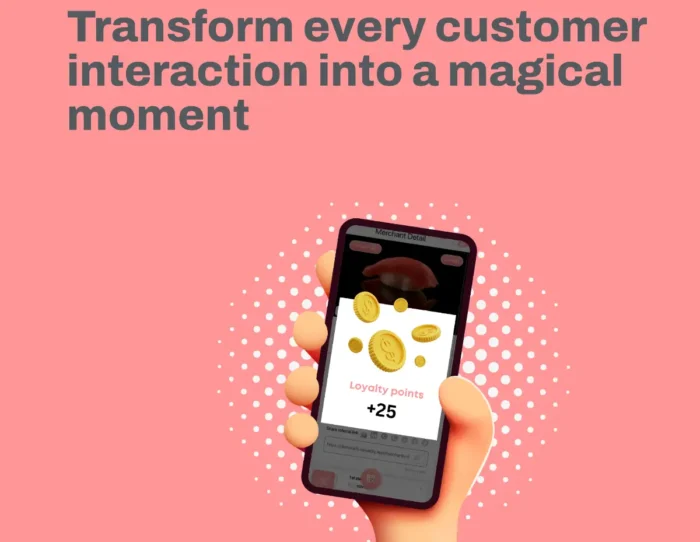
8. Stay Relevant
Regularly updating your products, services, and brand messaging to stay current with market trends keeps your brand relevant and at the top of your consumers’ minds.
Relevant brands maintain a strong connection by adapting to changing customer needs, market trends, and societal shifts. If you fail to stay relevant, your brand may become obsolete, losing its appeal and market position rapidly.
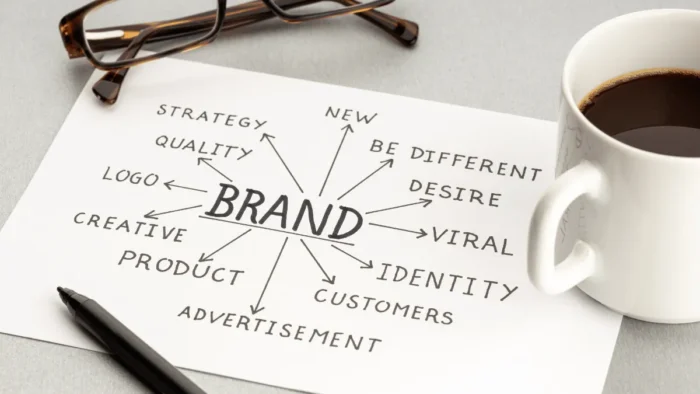
9. Focus on Your Customers
Putting your customers at the center of your business and catering to their needs, feedback, and preferences is the most powerful strategy for unlocking your brand’s potential. This customer-centric approach can organically grow your brand’s reputation and appeal.
Conclusion: The Evolution of Brand Potential
Your brand’s potential is not static; it evolves with the market, your customers, and the efforts you invest in it. By analyzing and employing the strategies outlined in this guide and continuously monitoring your brand’s performance, you can unlock new levels of brand potential and enjoy sustainable growth in an increasingly competitive business environment. Remember, brand potential is not just a marketing exercise – it reflects all aspects of your business working harmoniously to deliver value and exceed customer expectations.

